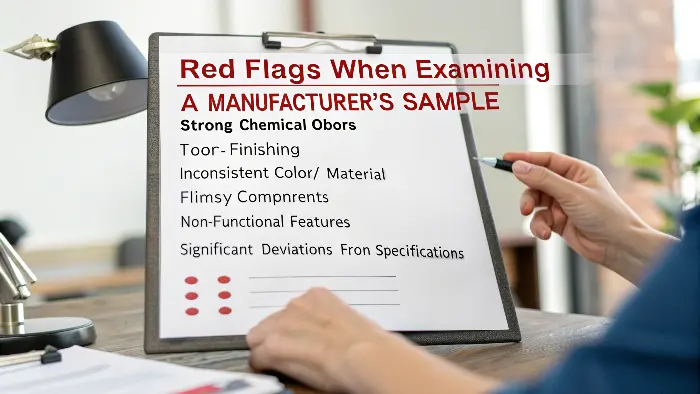Received that adult toy sample and now you’re just staring at it, unsure what to even look for? Worried you might miss a critical flaw that could sink your brand later? Imagine confidently assessing every sample, knowing exactly what signifies quality and what screams "run away!"
Evaluating adult toy samples from manufacturers effectively means going beyond a quick glance. You need a systematic approach, checking everything from the packaging and materials to the actual functionality and finish. This thoroughness is your best defense against costly mistakes and ensures you’re delivering what your customers expect—and deserve.
So, the courier just dropped off that sample you’ve been waiting weeks for. Exciting, right? But also a bit nerve-wracking. I’ve been there countless times. That little box holds so many hopes for your brand. As Jerry Zou, founder of PrivyPlay, I can tell you that this stage—sample evaluation—is absolutely critical. It’s where you separate the potentially great partners from the ones who will give you headaches down the line. Don’t just trust the pretty pictures they sent you; get your hands dirty! Let’s break down how I go about it, and hopefully, this will give you a solid framework.
What’s the First Thing I Should Check When My Adult Toy Sample Arrives?
Is your heart pounding a little as you reach for that freshly delivered sample package? Wondering if what’s inside will match your expectations or be a total letdown? It’s a make-or-break moment, isn’t it? Well, before you even rip into the product itself, there are some initial clues to look for.
The very first things to check when your adult toy sample arrives are the external packaging for any damage and the discretion of the shipping. Then, upon opening, assess the product’s immediate presentation—does it look and feel like a quality item? First impressions really do count for a lot here.
I remember one time, years ago, I was super excited about a new design. The supplier had sent me these glossy, amazing-looking renders. Then the sample arrived. Oh boy. The outer shipping box looked like it had gone ten rounds with a heavyweight boxer, and the "discreet" packaging inside was practically see-through! My heart just sank. That initial impression told me a lot about their attention to detail (or lack thereof) before I even touched the toy itself. It’s not just about the product, you see; it’s about the entire experience they’re capable of providing.
So, when that package lands on your desk, take a breath. First, look at the shipping box. Is it sturdy? Any dents, tears, or water damage? This tells you if they’re using adequate materials to protect your investment during transit. If it arrives looking battered, your future customers might receive damaged goods too. Not a good look.
Next, discretion of the outer packaging. For adult products, this is non-negotiable. Is it a plain box or mailer? Is the sender’s name generic? There should be ZERO indication of what’s inside. At PrivyPlay, we live by this – "Elevating Pleasure, Empowering Confidence" also means ensuring privacy from the get-go.
Then, you open it. How is the product’s own packaging (if it has retail packaging at this stage)? Is it crushed? Is the printing clear and professional? Does it align with the brand image you discussed? Sometimes, you might only get a sample in a polybag, especially for initial prototypes, and that’s okay. But if it’s meant to be a near-final sample, the packaging matters. Finally, your very first visual and tactile impression of the toy itself. Does it look clean? Does it feel right in your hand? Are there any immediate, glaringly obvious defects? Trust your gut feeling here; it’s often right.
How Do I Know If the Materials in My Adult Toy Sample Are Actually Body-Safe?
Staring at that sleek new adult toy sample, but a nagging doubt creeps in – are these materials genuinely safe for intimate use? Scared of inadvertently choosing a supplier who cuts corners on material quality, potentially harming your customers and your brand’s reputation? This is a legit concern, and probably one of the most important.
To ascertain if adult toy sample materials are body-safe, you must request and verify material safety certifications (like MSDS, RoHS, CE for relevant parts). Also, perform sensory checks: high-quality, body-safe silicone, for example, should be odorless, non-porous, and feel smooth, not sticky or oily.
This is a big one for me, personally and professionally. At PrivyPlay, our commitment to "Elevating Pleasure, Empowering Confidence" is built on a foundation of safety and quality. We only use body-safe materials, and we’re transparent about it. I’ve heard horror stories from other brand owners who got beautiful-looking samples, only to find out later (sometimes from angry customer reviews!) that the materials were cheap, porous, or even contained harmful phthalates. It’s a nightmare scenario that can destroy trust in an instant.
So, how do you avoid this? First, ask for documentation upfront. Before they even make the sample, you should be discussing materials. Specify what you want – medical-grade silicone, borosilicate glass, body-safe ABS plastic, etc. Then, when the sample arrives, ask for the Material Safety Data Sheet (MSDS) for the specific batch of material used. For electronics, CE and RoHS compliance are often key. Don’t just take their word for it; get the paperwork. A reputable manufacturer will have no problem providing this. If they hesitate or make excuses? That’s a pretty big red flag waving right there! 🚩
Next, use your senses.
- Smell Test: Good quality body-safe silicone should be virtually odorless. If the sample has a strong chemical smell, or a sweet, perfumey smell (sometimes used to mask other odors), be very wary. This can indicate cheaper, less stable materials or nasty plasticizers.
- Touch Test: How does it feel? Medical-grade silicone should feel smooth, perhaps a little velvety, but not sticky, oily, or overly tacky. If it feels like that cheap jelly material from way back when, that’s a no-go for premium products. It should also have a good "memory" – if you gently stretch it, it should return to its original shape without looking stressed.
- Visual Inspection (for materials): Is the color consistent? For silicone, are there any embedded particles or air bubbles? These can indicate poor manufacturing processes. For plastics, are there any flow marks or signs of cheap molding?
You can also do a simple flame test on a very small, inconspicuous part of a silicone sample if you’re comfortable and take extreme safety precautions (and honestly, this is more for the truly hardcore evaluators). Pure silicone burns to a white ash and doesn’t produce black, sooty smoke. Other rubbers or TPE will melt, smell foul, and produce black smoke. But again, this is advanced and potentially destructive, so prioritize certifications and the other sensory checks. For us at PrivyPlay, working with experienced entrepreneurs means we expect these questions, and we’re always ready to prove our material quality.Beyond Looks: How Can I Test the Functionality and Durability of an Adult Toy Sample?
Okay, the sample looks pretty good, and the materials seem to pass the sniff test. But does it actually work as intended? Are you worried that a toy that looks great on your desk might fall apart or underperform when it actually matters, leading to a flood of customer complaints? Let’s get practical.
To test an adult toy sample’s functionality and durability, you need to rigorously use all its features—buttons, vibration modes, charging ports—and assess its overall build quality. Simulate real-world use (and maybe even a little abuse) to see how it holds up over time. Don’t be gentle!

I always tell my team, and any brand owner I talk to: "Treat that sample like you’re its most demanding customer." Don’t just click the ‘on’ button once and call it a day. You’ve got to really put it through its paces. I learned this the hard way early in my career when a batch of what seemed like perfectly good vibrators had a button that would get stuck after about 20 clicks. Twenty! Imagine the returns. It was a painful lesson in thoroughness.
So, what does "rigorous testing" look like?
- Charge it Up (if applicable): How long does it take to fully charge? Does the charging indicator work correctly? Does it use a standard charging cable (USB-C is becoming a good standard) or something proprietary and annoying?
- Power On & Controls: Does it turn on and off easily? Are the buttons responsive? Are they intuitive to use, even in low light or, ahem, "in the moment"? If there are multiple modes or intensity levels, cycle through all of them. Repeatedly. Do they work consistently? Is the transition between modes smooth?
- Motor & Vibration Quality (for vibes): Is the vibration strong and rumbly, or weak and buzzy? High-quality motors deliver deep, satisfying vibrations. Listen to it – is it excessively loud? Some noise is expected, but it shouldn’t sound like a power tool. Does the vibration intensity feel consistent across all promised levels?
- Water Resistance/Waterproof Claims: If the manufacturer claims it’s waterproof (e.g., IPX7), test it! Submerge it according to the rating (e.g., IPX7 is 1 meter for 30 minutes). Make sure all ports are properly sealed if required. Then check thoroughly for any water ingress. This is a common point of failure if not manufactured correctly.
- Build Quality & Durability: Gently try to twist or bend it (within reason, don’t snap it in half on day one unless it feels really flimsy). Are there any creaks or squeaks? Check seams and joints – are they smooth and well-sealed, or are there gaps where water or dirt could get in? If it has moving parts, operate them. Drop it from a short height onto a soft surface (like a carpeted floor) – simulate an accidental drop. Does anything crack or come loose? You’re looking for resilience.
- Battery Life: If it’s rechargeable, use it until the battery dies. Does the runtime match the manufacturer’s claims? This takes time, but it’s worth checking.
This kind of testing takes a bit of effort, but it’s far, far cheaper than dealing with a warehouse full of faulty products and a legion of unhappy customers. This is what separates the pros from the wishful thinkers.What Red Flags Should I Watch Out For When Examining a Manufacturer’s Sample?
Feeling a bit uneasy about a sample, but can’t quite put your finger on what’s wrong? Worried you might overlook subtle warning signs that could point to bigger problems with the manufacturer or the product quality down the line? Trust me, those little alarm bells are often trying to tell you something important.
Key red flags when examining an adult toy sample include strong chemical odors, poor finishing (rough seams, glue residue), inconsistent color or material, flimsy components, non-functional features, and significant deviations from your agreed-upon specifications or design. Any one of these can be a deal-breaker.
 It’s easy to get excited when a sample finally arrives, especially if it mostly looks like what you envisioned. But this is where you need to be your own toughest critic. I’ve seen people get "sample happy" – they’re so relieved to have something tangible that they overlook small issues. Those small issues often become big, expensive problems in mass production. At PrivyPlay, we have a rigorous internal checklist for our own designs, and we expect our B2B clients to be just as discerning. It helps us both maintain high standards. Here’s a more detailed breakdown of red flags to keep an eagle eye out for: |
Red Flag Category | Specific Things to Look/Smell/Feel For | Why It’s a Problem |
|---|---|---|---|
| Odor | Strong chemical, plastic, or solvent smell. Overly sweet/perfumed scent. | Indicates cheap materials, poor curing, potential toxins, or attempts to mask odors. | |
| Material Quality | Sticky, oily, or overly tacky surface (for silicone). Too hard/brittle plastic. | Suggests non-body-safe materials, poor grade silicone, or material degradation. | |
| Finish & Assembly | Rough or sharp seams, visible glue, poorly fitting parts, uneven surfaces. | Poor craftsmanship, potential for discomfort/injury, Indicates sloppy production. | |
| Color & Appearance | Inconsistent color, specks or dirt embedded in material, scratches/scuffs. | Lack of quality control, poor molding process, careless handling. | |
| Functionality | Buttons hard to press/sticky, weak or erratic motor, features not working. | Product won’t perform as expected, leading to customer dissatisfaction & returns. | |
| Durability | Parts feel flimsy, creaks under slight pressure, charging port loose. | Product likely to break easily, short lifespan, poor value for money. | |
| Compared to Specs | Dimensions incorrect, wrong material used, features missing/different. | Manufacturer isn’t following instructions or has made unauthorized changes. | |
| Hygiene/Cleanliness | Sample arrives dirty, dusty, or with fingerprints. | Indicates poor handling and lack of care in the sampling/packing process. |
One client of mine was about to approve a sample that looked okay at first glance. But when we really dug in, we noticed a very faint, almost sweet smell from the silicone. The supplier brushed it off. We insisted on an independent lab test. Turns out, it was a lower-grade silicone with a scent additive to mask the slight chemical odor of the base material. Dodged a bullet there! Trust your instincts, but back them up with meticulous checking. Any single major red flag, or a collection of minor ones, is a serious reason to pause and reconsider that supplier.
Is Communicating Feedback on Samples to the Manufacturer Really That Important?
So you’ve meticulously examined your adult toy sample, noting down all the good, the bad, and the ugly. Now what? Feeling hesitant about how to deliver critical feedback without offending the manufacturer or, worse, having your concerns ignored? You might be surprised how vital this step actually is for both of you.
Yes, communicating detailed, constructive feedback on samples to the manufacturer is absolutely crucial. It’s not just about pointing out flaws; it’s a vital part of the collaborative process to refine the product, align expectations, and ensure the final production run meets your quality standards and brand vision.

Honestly, I think some brand owners feel a bit shy or awkward about giving really detailed, sometimes critical, feedback. Maybe they think it’ll sour the relationship or that the manufacturer will get defensive. But let me tell you, as a manufacturer myself (hello from PrivyPlay!), we want your feedback. How else can we make the product exactly what you and your customers need? Clear, specific feedback is gold. It helps us understand your standards and refine our processes. It’s a partnership!
Think of it this way: the sample is a prototype, a test run. It’s meant to be scrutinized. If you just say "looks good" when there are issues, you’re basically giving them permission to replicate those issues on a massive scale. That’s on you, then. I once worked with a new brand founder who was very polite but incredibly vague with her feedback on the first sample. We had to go back and forth three times on revisions that could have been sorted in one round if the initial feedback had been super clear and actionable. It wasted time and money for both of us.
So, how do you give effective feedback?
- Be Specific and Objective: Don’t just say "the quality is bad." Say, "The seam on the left side is rough and measures 0.5mm proud, while the right side is smooth. Please ensure all seams are flush and smooth as per specification X." Or, "Vibration mode 3 is noticeably weaker than modes 1 and 2; it should be the strongest."
- Use Visuals: Take clear photos and videos. Annotate them. Point arrows. Circle problem areas. A picture truly is worth a thousand words, especially if there’s any potential language barrier.
- Reference Original Specifications: If the sample deviates from what you agreed upon (dimensions, materials, features), point back to the original spec sheet or agreement.
- Prioritize Issues: If there are many small things, maybe list them as "minor revisions." If there are deal-breakers, make that crystal clear.
- Be Constructive and Professional: Even if you’re frustrated, maintain a professional tone. Explain why something is an issue from a user experience or brand quality perspective. Frame it as a collaborative effort to achieve the best product.
- Confirm Understanding: Ask them to confirm they understand the feedback and to explain how they will address each point.
This feedback loop is how good products become great products. It’s how we, at PrivyPlay, ensure that the adult toys we manufacture for our clients not only meet but exceed expectations, truly "Elevating Pleasure, Empowering Confidence." Don’t skip this step, and don’t be afraid to be thorough.Conclusion
Thoroughly evaluating adult toy samples is not just a step; it’s your frontline defense for brand quality and customer satisfaction. Taking the time to check everything meticulously, from packaging to performance, ensures you partner with the right manufacturers – like us at PrivyPlay!
